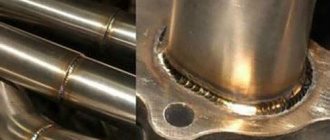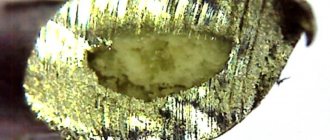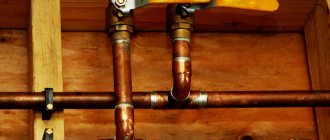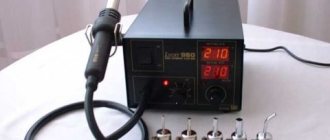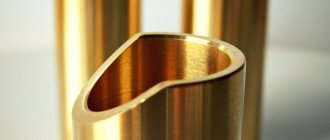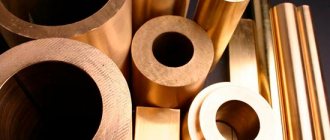Basic information about brass
Brass can be double or multi-component in composition. It is always based on two metals: copper and zinc. In this alloy, zinc serves as the main alloying component. To impart different properties, various metals are added to its composition: tin, lead, manganese. Therefore, it is very important to know what composition of brass you have to work with. This is necessary to determine the conditions and specifics of soldering.
Brass
Modern brass is classified according to the following indicators:
Depending on the chemical composition:
- Two-component alloys. It contains only two metals, zinc and copper. The percentage of each may vary. This type is marked with the capital letter of the Russian alphabet “L” and a number. The number indicates what percentage of copper is contained in the alloy. For example, grade L85 - this alloy contains 85% copper and the remaining 15% is zinc.
- Multicomponent. They are also called special. Such alloys contain a large number of additives. They are marked with two capital letters and numbers. For example, brand LA77-2. She indicates that the composition includes 77% copper, 21% zinc and 2% aluminum. Therefore, very often special brasses get their name depending on the name of the alloying element with the highest percentage (aluminum, tin, nickel, manganese, and so on).
By degree and quality of processing:
- Deformable. These include brass in the form of wire, round tube, sheet and tape.
- Foundries. These are fittings, finished products made of brass.
According to the zinc content in the alloy:
- If the zinc content is in the range from 5 to 20%, then such an alloy is called red brass (tompak).
- If this percentage ranges from 21% to 36%, the brass is called yellow.
All brands of brass have similar properties. They are easy to process, have high anti-corrosion characteristics, and have sufficient strength. With a significant decrease in temperature, they retain their plasticity.
These properties have determined the wide range of uses of brass.
Features of soldering copper alloys
In everyday life, various parts are often used in which brass and bronze are used. These copper alloys are very similar in appearance, but have different compositions and their own characteristics. Brass is a copper-zinc alloy with the addition of tin, aluminum and other metals. Bronze is an alloy of copper with tin, aluminum, lead and other substances. Brass, to which tin is added, approaches the composition of bronze, but still its basis is zinc.
Materials and tools for soldering brass products.
Soldering brass has its own inherent difficulties. When exposed to heat, zinc actively evaporates from the alloy, forming a dense film of zinc oxide and copper. The zinc oxide film is destroyed with great difficulty, and its formation occurs quite quickly when the zinc content in brass is more than 15%. Rosin, even in combination with alcohol, cannot cope with such a film, which requires the use of special fluxes.
If you use tin-lead solder when soldering brass, the connection has low mechanical strength. Thus, where brass is soldered with tin-lead solder, its strength is 1.6 times less than that of copper. This is due to the appearance of pores in the soldered seam due to the evaporation of zinc.
Methods for soldering bronze depend on its composition. Tin and nickel bronzes are easily soldered with tin-lead solders. When soldering aluminum and beryllium bronzes, difficultly soluble films arise, which necessitates the use of special solders and fluxes.
Application of brass
In addition to the listed positive properties, brass is a very durable and reliable alloy. Brass is used in the following areas:
- Manufacturing of pipeline fittings (adapters, valves, pipes).
- Plumbing fixtures (taps, mixers, washbasins)
- Furniture fittings (handles, latches, locks, decorative overlays).
- Production of electrical parts.
- Production of souvenirs.
- Production of tableware.
- Art casting.
- Jewelry production. Jewelers mainly use two-component alloys. It can be: yellow, red, green or golden brass.
Soldering brass pipes
How to use brass solder
Before soldering can begin, the product must be assembled. To do this, individual parts are fastened together using metal wire (bindra). When the preparation is completed, everything is placed together in a gorg, where heating occurs until the metal is red-hot. Extreme care must be taken when laying. A poker is used to clear space in the coals for the product; the fuel remains on the grate in a fairly large and even layer. When working with coal, it is important to ensure that it does not fall on the forge, even in the smallest pieces. The blowing of the forge should not be strong in order to obtain uniform calcination.
Read also: Drill sizes for confirmations
As a rule, borax acts as a flux. Before application, it is moistened with water over the entire surface, after which soldering begins. Leaving the flux in place, take a rod of brass and run it where the connections should be. At this moment, the flame in the forge changes its color to green. During the soldering process, the product blank should not move or move from its original location. This will help to avoid accidental displacement of parts relative to each other, so as not to spoil the seam, both from the point of view of visual appeal and the reliability of the seam.
Table of composition and application of solders.
If the composition contains many elements, then welding occurs differently. In those places where soldering will be done, from the very beginning the brass is laid out in pieces, in the expectation that when heated it will begin to spread, as a result of which the parts will be held together.
Brass can be used in individual pieces, shavings or sawdust, sprinkled in the welding areas. At the same time, they must meet the requirements of purity so that there are no impurities or foreign inclusions. Iron filings and other small metal parts are removed using a magnet.
To solder smaller parts, clay with salt added to it is used as a fastening material. But when assembling individual parts, the wire used for fastening is not iron, but brass. After this, the product is sprinkled with borax, coated with clay and carefully placed on a sheet of metal, which is sent to the forge. You also need to blow lightly; the clay should be heated evenly. After it dries, the air supply becomes more active. Clay that has begun to crack indicates that the parts are securely fastened together. Soldering of individual parts occurs using brass wire, which at this point melts and holds the parts together. At the end of the process, the forge is turned off, the finished forged product must cool down. The final stage is to remove clay and flux, and remove excess solder with a file.
Solders and fluxes: classification and selection methods
To obtain good soldering results, additives in the form of fluxes and various solders must be used.
Solder is a specific metal that, after melting, penetrates into metals prepared for soldering.
To achieve reliable contact, the brand of solder must have a melting point that will be significantly lower than the melting point of the brass itself. At the same time, it must have good adhesion to brass. Therefore, special solders are used for soldering brass.
Only as a last resort, if parts are soldered that do not bear much responsibility for the entire unit, and there are no high requirements for strength, ordinary tin-lead alloys are used.
Modern solders are classified as follows:
- By melting point. They are soft with a melting point reaching 400°C; semi-solid with the melting point of tin and solid. The melting point of hard solders exceeds 500 °C.
- By type of melting. Solders that melt completely or partially during the soldering process.
- According to the method of obtaining solder. We produce ready-made solders, and solders that are formed during the soldering process. This type of soldering is called contact reactive soldering.
- According to the list of chemical elements added to the composition. A fairly large number of such elements are used. From common metals zinc, tin, aluminum, to rare earth metals gallium, indium, palladium.
- According to solder manufacturing technology. They are: wire, stamped, rolled, cast crushed.
- By type of solder. They are produced in the form of wire, ready-made powder, in the form of tape and individual sheets, in the form of tablets and ready-to-use embedded parts.
- According to the method of flux formation. Solders are divided into two large categories: fluxed and so-called self-fluxing.
Solders, like brass, are marked with capital letters and numbers. By the marking you can determine which brass a particular solder is intended for. For example, if it is necessary to solder a part made of brass, in which there is a large percentage of copper, then it is proposed to use solder of the PSr12 or PSr72 brand. This solder contains a large percentage of silver. If there is a large percentage of zinc in brass, then it is advisable to use PSr40 solder. Therefore, in order to obtain a reliable connection after soldering, it is necessary to understand what loads are placed on the part being repaired. If the part is stationary and does not bear large vibration loads (for example, plumbing elements), you can safely use PMC solder. If it is necessary to ensure a strong connection, special hard solders are used, such as L-CuP6. This solder has a very high melting point - 730 ° C.
Solders for brass
To choose the right brand of solder, you can use the following method:
- Determine the melting temperature of the parts that are planned to be soldered.
- Determine the coefficient of thermal expansion. For brass that you plan to solder and the solder it should be very close.
- After soldering, the solder should not reduce the mechanical characteristics of the repaired part.
- The solder must form a galvanic couple with the main brass part. If this is not ensured, the corrosion process will quickly occur.
- The properties of the solder must comply with all technical and operational characteristics.
- The solder must ensure good wettability of the main part during the soldering process.
Flux is a special substance that allows you to prepare the surface of the metal, that is, remove the resulting oxide deposits, grease and water stains from it. Without the use of flux, it is impossible to qualitatively solder a brass part. Fluxes are selected depending on the chemical composition of brass.
Experience shows that in order to qualitatively solder parts made from common brands of brass LS59 and L63, it is enough to have a flux consisting of zinc chloride dissolved in boric acid. If you need to solder brass, which contains lead and silicon (for example, LKS80 brand), then you need a flux containing fluorine and potassium compounds. They are also dissolved in boric acid, or borax. A similar flux for soldering can be prepared at home, using the appropriate elements in the required percentage.
Flux paste for soldering brass
Today, the industry offers ready-made fluxes for brass soldering. These include: Borax flux; fluxes PV-209 and PV-209X.
Making your own solder
Silver solders are also suitable for packing brass.
In order to solve the problem of soldering brass, you should prepare the necessary solder with your own hands. Silver solder is most suitable for all brasses; it should be prepared. Melting of metals must be carried out in a crucible that can withstand significant thermal influences. Most simply, such a crucible is made from contact carbon elements for trolleybuses. Burnt elements are quite accessible and can be useful for a crucible. A recess measuring approximately 2x2 cm is made in such a graphite element, and a groove about 5 mm wide is machined into the recess (to facilitate removal of solder).
Solder requires silver and copper in a 2:1 ratio. The required amount of metal is measured and lowered into the crucible. Using a gas burner, metals are melted in a crucible. To simplify the melting process, the metals should first be crushed as much as possible. The melt is mixed with a steel or ceramic (porcelain) rod. After cooling, such an alloy can be used as solder.
Soldering methods
The brass soldering process has certain specifics. The brass heats up and the hot zinc elements evaporate. At this moment, an oxide film is formed, which is quite difficult to remove from the surface of the part and thereby deteriorates the quality of soldering. Usually brass is soldered in two ways: using a soldering iron and using a special torch.
Soldering with a soldering iron
To successfully solder brass, a soldering iron must have a power of at least 1000 W. Such a soldering iron will provide the required heating temperature for the parts themselves and the solder. It should be 500ºС and above. Low temperature soldering of brass is only possible if it has a high percentage of copper content.
Soldering brass with a soldering iron
The most convenient way is to solder using a soldering station, which has an adjustable soldering iron tip temperature. This adjustment allows you to set the optimal heating mode. The point is that during soldering it is necessary to avoid unnecessary overheating of the soldering area. The optimal temperature for heating the soldering iron tip is up to 350°C.
Necessary tool
If you have decided what to solder with, then you should also decide what to cook. When soldering brass, you will need the following tools and accessories:
- soldering iron with a power of 100 W and 0.5-1 kW;
- gas burner complete with gas cylinder;
- crucible;
- scales;
- vice;
- knife;
- scissors;
- file;
- pliers;
- clamp;
- sandpaper;
- brush;
- brush.
Brass is very often used in various household devices, so when they break, the question arises of how to solder brass. Such soldering is quite possible, but requires certain conditions and rules to be met.
Brass soldering is used when you need to connect small metal parts. For example, it is used in artistic forging when assembling a general composition or in a home workshop. In this case, ornamental steel with a flat or square cross-section is most suitable, where the contact area is larger than that of round rods. In addition to the fact that brass can be used as a solder to solder parts made from this material, there are also some tricks to get a high-quality seam.
Scheme of soldering metals with brass using a gas torch.
Soldering brass with a gas torch
Quite often craftsmen wonder how to solder brass. If it is necessary to fasten brass parts, a slightly different technology is used. Brass parts lend themselves well to processing, soldering, after which they are specially blackened. Many people use tin as solder in this case: it is available in almost every workshop and is easily melted with a regular soldering iron.
Diagram of a gas burner.
The method is quite simple, but has significant disadvantages:
- the finished seam stands out against the background of brass with a white color, while it is not immediately thin and neat for everyone;
- the seam turns out to be fragile and cannot withstand bending;
- During the blackening process, both metals behave differently, the tin weld is different from the brass part in color, they have different shades.
Soldering with a gas torch using special solder for brass and flux will help to avoid such problems. As a result, the weld is difficult to distinguish from the base metal of the product by color; it is highly durable, and in its chemical composition it is much more similar to brass than tin.
Working with brass is more likely to be welding due to the high temperatures for which an ordinary soldering iron is not suitable, but it is commonly called soldering mainly due to the fact that solder is used.
First of all, the solder is prepared.
It consists of silver and copper in a ratio of 2:1, which must be fused together on a gas burner. Copper is more refractory, so you can start with it and then pour in the molten silver and mix with a wire bent into a hook. The finished solder is cooled, rolled out in a roller or on an anvil, and then cut into pieces. There is a more accessible way: using a coarse file, go over the casting to form chips.
Next, flux is prepared. Powdered borax is mixed with powdered boric acid in equal parts of 20 g, after which it is poured with a glass of water. In order for the ingredients to dissolve well, it all needs to be boiled. As one of the options for use, it can be recommended to evaporate the water, calcinate the solid ready-made flux and grind it into powder, which is subsequently mixed with solder.




